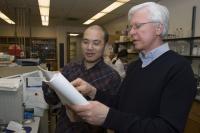Apr 5 2010
A $1.1 million award was approved to the University of Cincinnati (UC), Riehl Engineering and YSI Inc. by the Ohio Third Frontier Commission for an ‘Advanced Modified Carbon Nanotube-Based Nutrient Sensor’ project.
 Professor William Heineman, University of Cincinnati
Professor William Heineman, University of Cincinnati
This project will focus on the development of a sophisticated nutrient sensor that will help to monitor environmental waters for the presence of nitrate. Nitrate is a critical pollutant found in agricultural runoffs and waste waters. Environmental information related to these water bodies is collected by sensors that are located in the field under observation or remotely.
The chemical compound nitrate is usually present in fertilizers. Nitrate is created by microbes responsible for breaking down nitrogen-containing plant residues existing in the soil. These nitrates are washed into rivers and streams by storm water runoffs. The nutrient nitrate feeds algae and plants residing in water. However, excess of nitrate results in growth surges, resulting in choking of fishes and other animals.
Industries will have to monitor nitrates percolating into a community’s drinking water, as stipulated by a number of requirements and regulations. These include the National Pollutant Discharge Elimination System permits laid down by the Emergency Planning and Community Right to Know Act, the Clean Water Act, and the Safe Drinking Water Act. So far monitoring of nitrate in drinking water was cumbersome and the process involved usage of sensors that weighed around 80 pounds and had a size of around 45 gallons. Efforts of the project research team will result in sensors, presently in the development stage, that are as small as a third of a pencil’s size. This sensor can be fitted inside a smart probe that measures the size of an AA flashlight. The research team hopes that the sensor will motivate individuals and industries to monitor their nitrate runoff.
A Raman microscope will be procured for the UC Sensor Instrumentation Laboratory as part of this project. The microscope is valued at greater than a quarter of a million dollars. Funds will also be provided to a graduate student for working on the project.